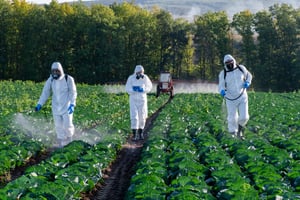Organochlorine pesticides are synthetic compounds that were historically used in agriculture to...
The Upsides and Downsides of Pesticides
Pesticides are a broad class of substances used around the world to control a large variety of pests, and they fall into several major categories defined by the type of pest they are intended to mitigate. For example, insecticides target unwanted insects, herbicides eradicate competing flora, and fungicides combat errant fungi. For a long stretch of human history, people have relied on pesticides to protect crops – and thus their food source – from pests (1). Today, pesticides in general are broader in concept and are used to control disease carrying insects, such as mosquitos, and to protect crops from damaging insects and weeds and thereby maintain or increase food production (2). Because of these important uses, the global consumption of agricultural pesticides reached more than 2.6 million metric tons in 2020 (3).
While the critical role of pesticides in modern society is undeniable, their use has some notable and even dangerous downsides. Pesticides can negatively impact biodiversity and water quality and can be toxic to non-targeted organisms (4). Appropriate pesticide stewardship is critical to maintain the balance between benefit and harm.

Who regulates Pesticides?
Across the globe, governments deploy different strategies for approving and monitoring the pesticides that are marketed and applied in their countries.
In the United States, all pesticides that are sold, including imported materials, must be registered by the EPA. There are two major statutes that grant regulation authority to the EPA: the Federal Insecticide, Fungicide, and Rodenticide Act, and the Federal Food, Drug, and Cosmetic Act, both of which were amended by the Food Quality Protection Act and the Pesticide Registration Improvement Act. Under these regulations, pesticide manufacturers are required to develop appropriate analytical methods for environment and residue analysis and provide them to EPA as part of product registration. Once a pesticide is registered, anyone using it – entity or individual – must comply with both federal and state laws. Typically, compliance monitoring and enforcement against illegal use is performed at the state level. In most cases a state's department of agriculture or environmental agency has this responsibility (5).
On the other hand, the European Union requires an authorization process that includes three groups, EFSA, the European Commission and Member States. EFSA carries out the necessary risk assessments and provides the European Commission the data and scientific evidence required for the decision-making process. The European Commission, in consultation with Member States, makes the decision on whether to approve an active substance. The European Commission is also responsible for setting the methodology to be used in the regulatory assessments, including the scientific methodology (6) . These same parties participate in annual monitoring of pesticide use and residues (7).
Major Types of Pesticides
Pesticides can have either inorganic or organic chemistry. Inorganic pesticides do not contain carbon and can often be derived from nonliving, natural sources such as mineral ores. Pesticides in use today often are produced synthetically and are designed to target specific pest organisms.
Examples of synthetic organic pesticide groups:
- Organophosphate Pesticides are typically utilized as insecticides. Some are known to be extremely poisonous; however, they are not usually persistent in the environment.
- Carbamate Pesticides are commonly used as insecticides. There are at least 40 carbamate insecticides.
- Organochlorine Pesticides are a group of insecticides that have mostly been removed from the market and use due to negative health and environment effects and their persistence in the environment.
- Pyrethroid Pesticides are man-made insecticides that are synthetic versions of naturally occurring pyrethrin, a pesticide found in chrysanthemums.
- Triazines are a group of herbicides that has been used as a selective weedkiller.
- Triazoles are fungicides that are widely used to prevent fungal disease in agriculture.
- Neonicotinoids are a class of insecticides that is chemically like nicotine. Over the last decade neonicotinoids have been increasingly suspected of contributing to the collapse of bee colonies, resulting in increased restrictions, particularly in the EU (8).
Analysis of Pesticides
The continuously evolving requirements of agriculture and governmental regulations, paired with increased globalization, make ongoing and standardized pesticide analysis extremely critical. Pesticide testing is necessary to meet the detailed registration requirements for pesticides outlined previously. Additionally, monitoring for the presences of pesticides or their metabolites in environmental, water, food, feed, and human samples is by far the best way to protect against collateral negative consequences.

Whether the analysis is being performed in an ISO 17025 accredited laboratory or not, high quality pesticide reference materials are a critical tool, and their use ensures that the highest level of data accuracy is obtained.
Our Chem Service organization has been making analytical standards for pesticide analysis for decades and has a complete portfolio of pesticide reference materials to support your laboratory needs.
References
- https://ourworldindata.org/pesticides
- https://www.epa.gov/safepestcontrol/why-we-use-pesticides#:~:text=Pesticides%20are%20used%20to%20control,be%20effective%20against%20specific%20pests
- https://www.statista.com/statistics/1263206/global-pesticide-use-by-type/
- https://www.usgs.gov/centers/ohio-kentucky-indiana-water-science-center/science/pesticides
- https://www.epa.gov/pesticide-registration/about-pesticide-registration#:~:text=Federal%20Insecticide%2C%20Fungicide%2C%20and%20Rodenticide%20Act%20(FIFRA)%20%2D,benefits%20of%20a%20product's%20use
- https://www.efsa.europa.eu/sites/default/files/corporate_publications/files/Pesticides-ebook-180424.pdf
- https://multimedia.efsa.europa.eu/pesticides-authorisation/index.htm
- https://www.pcs.agriculture.gov.ie/foodsafety/themonitoringandcontrolsprogramme/themainpesticidetypes/

.png?width=50&name=MicrosoftTeams-image%20(1).png)


